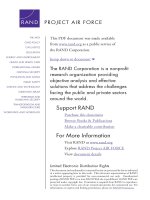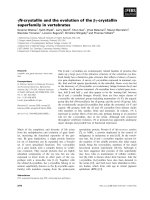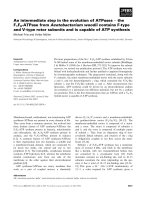4 ERM the next step in the evolution of business management
Bạn đang xem bản rút gọn của tài liệu. Xem và tải ngay bản đầy đủ của tài liệu tại đây (661.66 KB, 41 trang )
ERM: The Next Step in the Evolution of
Business Management
Sim Segal, FSA, CERA, MAAA
Adjunct Professor
Columbia Business School
Decision, Risk & Operations
Shanghai Jiao Tong University EMBAs
Asia-Pacific Development Society, Columbia University
April 22, 2010
Agenda
Drivers of ERM adoption
ERM challenges
Defining risk
Defining ERM
ERM approaches
ERM and the financial crisis
Appendices
Contact information
2
Copyright © SimErgy. All rights reserved.
Drivers of ERM adoption
Events
•
•
•
•
Accounting fraud (e.g. Enron)
September 11th
H1N1 pandemic
Financial crisis
Stakeholders
• Rating agency scrutiny
• SEC Feb 2010 disclosure rule
Other
• Technology
• Increased risk savvy
3
Copyright © SimErgy. All rights reserved.
ERM challenges
Confusion over what ERM is
– Providers jumping into the market, portraying
traditional risk-related products and services as ERM
o Consultants
o Auditors
o Insurance brokers
o Technology firms
Full promise of ERM still not realized
– Best practices not yet widely identified
4
Copyright © SimErgy. All rights reserved.
Defining risk
Uncertainty
– Is anything 100% certain? Death and taxes?
Includes upside volatility
– A bit unusual, but important for our purposes (all
volatility impacts a company’s value, e.g., discount
rate of future free cash flows)
Deviation from expected
– Not just “loss” but loss above and beyond expected
loss in Strategic Plan
5
Copyright © SimErgy. All rights reserved.
DEFINING ERM
6
Copyright © SimErgy. All rights reserved.
Basic definition of ERM
“The process by which companies identify,
measure, manage and disclose all key risks
to increase value to stakeholders”
7
Copyright © SimErgy. All rights reserved.
ERM 10 key criteria
1) Enterprise-wide – all areas in scope
2) All risk categories – financial, operational & strategic
3) Key risks only – not hundreds of risks
4) Integrated – captures interactivity of 2+ risks
5) Aggregated – enterprise-level risk exposure/appetite
6) Decision-making – not just risk reporting
7) Risk-return mgmt – mitigation plus risk exploitation
8) Risk disclosures – integrates ERM information
9) Value impacts – includes enterprise value metrics
10) Primary stakeholder – not rating agency-driven
8
Copyright © SimErgy. All rights reserved.
ERM process cycle
Risk
Identification
Risk
Quantification
Risk
Messaging
Risk
DecisionMaking
9
Copyright © SimErgy. All rights reserved.
Benefits of ERM
Shareholders
• Increased likelihood company achieves strategy
• Enhanced risk disclosures
Board of directors
• Assurance key risks well understood / managed
• Compliance with SEC Feb 2010 disclosure rule
C-Suite
Management
Rating agencies
Regulators
• Better stakeholder communications
• Higher stock price
• Stronger rating
• Tools to manage exposure within appetite
• Better risk-return decisions
• Prospective information for better credit risk
assessment
• Lower systemic risk
10
Copyright © SimErgy. All rights reserved.
ERM APPROACHES
11
Copyright © SimErgy. All rights reserved.
Obstacles in traditional ERM frameworks
1) Quantifying operational and strategic risks
2) Defining risk appetite
3) Integrating ERM into decision-making
12
Copyright © SimErgy. All rights reserved.
Value-Based ERM Framework
Risk Appetite
Strategy
Risk
Mgmt
Tactics
Qualitative
Assessment
ERM
Committee
Scenario
Development
Value Impact
Enterprise Risk
Exposure
24
32
22
21
17
18
5
15
26
12
3
25
34
1
16
35 27
2
31
19
28
6
23
30
13
11
4
8
20
14
10
All
Risks
9
7
Likelihood
Key Risk
Scenarios
Correlation
Likelihood
Severity
33
29
Mostly Objective
X
Enterprise Value
FINANCIAL
Market
Credit
…
STRATEGIC
1+ events / sim
Key
Risks
Strategy
1 event / sim
Mostly Subjective
Execution
…
ERM
Model
Baseline
Value
▪ ΔValue
OPERATIONAL
HR
“Pain Point”
Likelihood
ΔValue ≤ -10%
15%
ΔValue ≤ -20%
3%
Individual Risk
Exposures
Enterprise Value Impact
IT Risk 1
Legislatiion Risk
Process
Loss of Critical EEs
M&A Risk
…
Execution Risk
International Risk 1
Loss of Key Supplier
Loss of Key Distributor
IT Risk 2
International Risk 2
Union Negotiations
Competitor Risk 1
Consumer Relations Risk
0.0% -5.0% -10.0% -15.0% -20.0% -25.0%
Identification
Quantification
Decision-Making
1) Quantifying operational and strategic
risks
Traditional Approach
Value-based Approach
Method 1:
Qualitative
Cannot support
decision-making
Quantifies impact to value /
supports decision-making
Method 2:
Industry data
Often unavailable or
inappropriate
Company/situation-specific
Understates risk
Fully quantifies risk impacts
Arbitrary / often
directionally incorrect
Risk-based
Method 3:
Risk capital
See Appendix 1: Examples of operational and strategic risks
14
Copyright © SimErgy. All rights reserved.
ILLUSTRATIVE
EXAMPLE
Developing risk scenarios: FMEA
1) Identify interviewees
- Those closest to the risk
- Usually 1 or 2 risk experts
Risk: Legislation Risk
Attendees: xxx, xxx, xxx
Scenario 1: Legislation passes reducing business
opportunity in certain markets
Likelihood: 5%
2) Develop risk scenario
- Begin with credible worst case
- Select specific scenario and think it through
3) Assign likelihood
Financial impact:
• Revenue impact
o 50% loss of planned revenues in market A
• 1st year: -$2.5M
• 2nd year: -$2.6M
• etc.
o 100% loss of planned revenues in market B
• 1st year: -$1.0M
• 2nd year: -$1.1M
• etc.
Expense impact
o Reduction in workforce
• -10% of salary and related benefits
• +$100K severance costs
4) Quantify
- Determine impacts on free cash flow
15
Copyright © SimErgy. All rights reserved.
Modified
Case
Study
Modified case study: Quantifying individual
risk exposures on enterprise value basis
Individual Risk Quantification
Enterprise Value Impact
IT Risk 1
Legislatiion Risk
Loss of Critical EEs
M&A Risk
Execution Risk
International Risk 1
Loss of Key Supplier
Loss of Key Distributor
IT Risk 2
International Risk 2
Union Negotiations
Competitor Risk 1
Consumer Relations Risk
0.0%
-5.0%
-10.0%
-15.0%
-20.0%
-25.0%
16
Copyright © SimErgy. All rights reserved.
Modified
Case
Study
Modified case study: Quantifying individual
risk exposures on multiple bases
Risk
Δ Enterprise Value
Δ Revenue Growth
Δ EPS Growth
1
IT Risk 1
-23.0%
-5.3%
-7.4%
2
Legislation Risk
-19.0%
-17.0%
5.9%
3
Loss of Critical EEs
-14.5%
-8.9%
-9.5%
4
M&A Risk
-8.7%
0.0%
-3.7%
5
Execution Risk
-7.9%
-1.1%
-4.1%
6
International Risk 1
-5.8%
-1.8%
-4.0%
7
Loss of Key Supplier
-5.5%
-0.9%
-3.3%
8
Loss of Key Distributor
-4.4%
-2.7%
-2.2%
9
IT Risk 2
-3.0%
0.0%
-1.4%
10
International Risk 2
-2.8%
-2.0%
-1.7%
11
Union Negotiations
-2.0%
-1.3%
-1.0%
12
Competitor Risk 1
-2.0%
-1.8%
-0.8%
13
Consumer Relations Risk
-1.5%
-1.2%
-0.5%
17
Copyright © SimErgy. All rights reserved.
Case
Studies
Case studies: Quantifying impact to
value supports decision-making
A) Technology – External attack
B) Human resources – Critical employees
C) Fraud – Money Laundering
D) Supplier – Disruption
E) Technology – Data Privacy
F) Strategy – Strategic Planning Process
18
Copyright © SimErgy. All rights reserved.
Case study A
Technology – External attack
Sector
Financial services
Event
External attack through unprotected wireless device leading to
numerous impacts on systems, data and customers
Quantification
Ranked as #3 risk by value impact
Primary driver found to be customer privacy data violation
Management
action(s)
Make two immediate decisions:
1) Identified and secured PCs with customer data
2) Purged ex-customer data, cutting exposure in half
Lessons
Value metric leads to decision-making
Attribution focuses mitigation opportunities
19
Copyright © SimErgy. All rights reserved.
Case study B
Human Resources – Critical employees
Sector
Insurance
Event
Plane crash results in death of some top salespeople, sales
managers and executives
Quantification Attribution identified sales managers as primary driver
Management
actions(s)
Decision to strengthen adherence to company policy limiting
concentration of key employees on flights, particularly for
sales managers
Lessons
Value metric superior to traditional capital metric, which does
not rank this risk properly
Attribution focuses mitigation opportunities
20
Copyright © SimErgy. All rights reserved.
Case study C
Fraud – Money Laundering
Sector
Insurance
Situation
Decision needed on whether to resume AML spending
Event
Money laundering violation with fines and criminal prosecutions
Quantification Destroys approximately half the company’s value
Management
actions(s)
Immediate decision to continue AML spending
Lessons
Quantification exercise adds value, despite approximate
nature of inputs
Value metric leads to decision-making
21
Copyright © SimErgy. All rights reserved.
Case study D
Supplier – Disruption
Sector
Chemical manufacturer
Event
Sole source supplier facility destroyed by fire
Ranked as #1 risk by value impact
Quantification 100% destruction of minor product line
Market share loss in major product line, some permanent
Management
actions(s)
Immediate decision to qualify backup supplier
Lessons
Value metric fully quantifies impact, including future years
FMEA process translates and shares experts’ knowledge
22
Copyright © SimErgy. All rights reserved.
Case study E
Technology – Data Privacy
Sector
Telecommunications
Situation
Rapid decision needed on response to customer request to
guarantee data privacy
Event
Multiple scenarios under each of three decision options
Quantification Produced within required short time frame
Management
actions(s)
ERM information helped management arrive at their decision
Lessons
Value-based ERM model can be modified and run rapidly,
making it practical to include in decision-making process
Value metric is the language of business decision-makers
23
Copyright © SimErgy. All rights reserved.
Case study F
Strategy – Strategic Planning Process
Sector
Technology
Event
Strategic plan process is unrealistic, and 4 elements of the plan
are not achieved
Quantification
20% drop in enterprise value from baseline valuation
Attribution identified which of the 4 elements most impactful
Management
actions(s)
Realized source of bias, vis-à-vis stock options
Focused attention on achieving most impactful elements
Lessons
Value metric is relatable to existing business metrics
Attribution focuses mitigation opportunities
24
Copyright © SimErgy. All rights reserved.
2) Defining risk appetite
Traditional
Approach
Value-Based
Approach
Multiple, competing metrics
Single, unifying metrics
Trade-off decisions
between exposures?
X
Aggregated enterprise
risk exposure?
X
Ability to set risk limits by
cascading downward?
X
Metrics
25
Copyright © SimErgy. All rights reserved.









